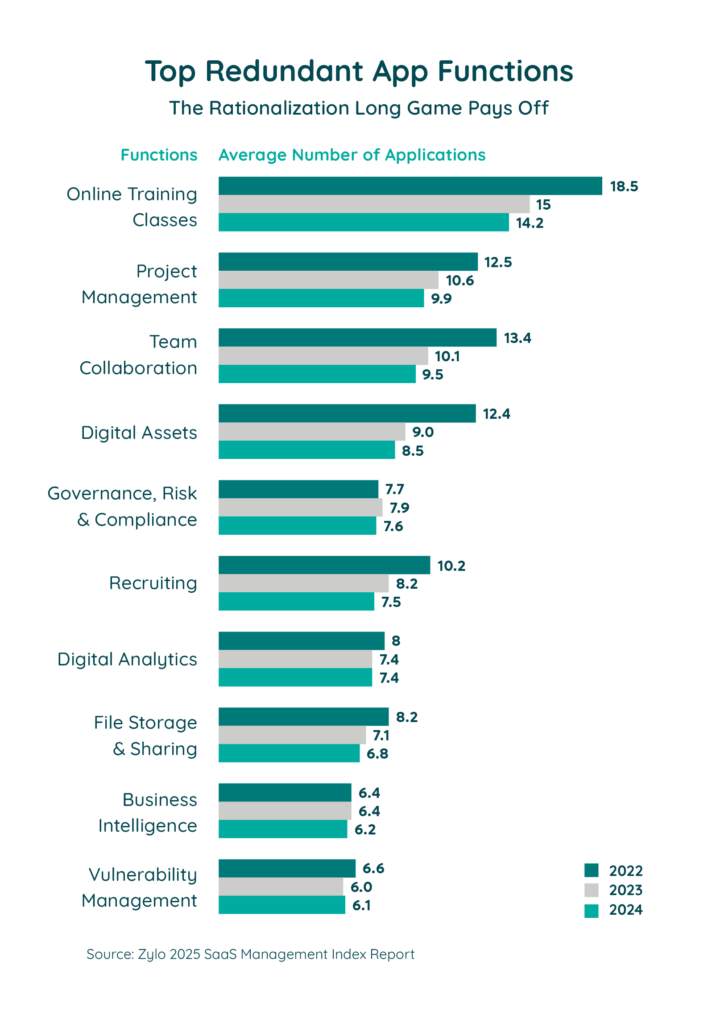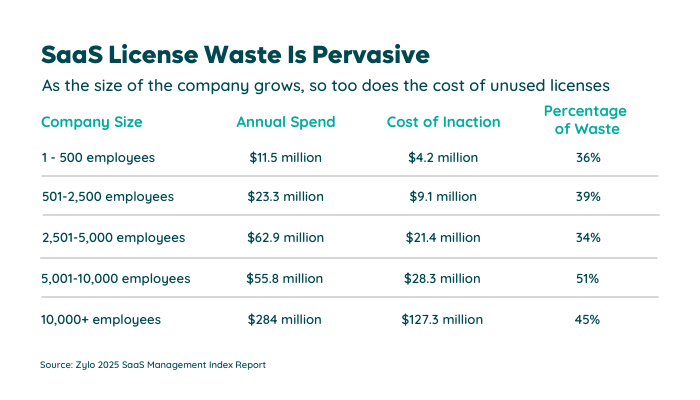
Zoom License Cost 2026: Which Plan Offers the Best Value for Your…
Table of Contents ToggleWhat Is SaaS Consolidation?Why SaaS Consolidation Matters for...
Back
Back
Search for Keywords...
Blog

Table of Contents
If your company feels weighed down by too many SaaS tools, you’re not alone. Over time, it’s easy to end up with overlapping apps, multiple contracts, and rising subscription costs that don’t always match the value you’re getting.
That’s where SaaS consolidation comes in. It’s about stepping back, looking at the big picture, and deciding which tools you really need to keep—and which ones can be cut or combined. With a clear consolidation strategy, you can cut unnecessary spending, simplify management for your IT team, and make everyday work smoother for your employees.
SaaS consolidation is the process of reducing overlapping applications or duplicate purchases. It results in a leaner, easier-to-manage environment where every app serves a clear purpose and drives value for the business.
SaaS consolidation is a critical lever for cost control and efficiency in the following areas:
The main drivers of SaaS consolidation include:
Companies usually don’t decide to consolidate SaaS tools without a clear reason. Instead, they see specific issues piling up that make consolidation the smart move.
When separate teams adopt different apps for the same purpose, inefficiencies grow. According to the 2025 SaaS Management Index, redundancy is common. The top most redundant functions included:
Employees end up duplicating work, while IT must support multiple systems that solve the same problem. Consolidation resolves these overlaps by unifying teams on shared platforms.

Duplicate subscriptions and unused licenses quietly drain resources. In 2025, our data showed that license waste per organization averaged $21M annually. Finance leaders notice rising SaaS spend without clear business value, forcing action. Consolidation addresses the issue by cutting waste and centralizing contracts.

Every additional application requires more integrations, permissions, and troubleshooting. As portfolios expand, IT struggles to keep pace with maintenance and support. That’s because, in 2025, IT only managed just 26% of spend and 16% of apps. Consolidation eases that load by shrinking the footprint of tools IT must oversee.

The more apps in play, the harder it is to enforce consistent security standards. Shadow tools can slip through, leaving blind spots for auditors. Consolidation reduces the number of access points and data flows, closing those gaps.
Switching between dozens of tools slows productivity and causes friction. Employees waste time learning redundant apps or struggling with inconsistent processes. Consolidation streamlines their experience by focusing usage on a smaller, unified set of applications.
The No-BS SaaS Management Playbook
Learn MoreAI adoption drives consolidation because it expands shadow usage, increases spend for AI features and consumption fees, and raises the stakes for security and compliance.
Key impacts at a glance:
Bringing AI into your business does not just mean adding new tools. It often requires rethinking the ones you already have. As more features like automation and analytics appear inside SaaS platforms, the overlap between apps becomes harder to ignore.
According to the State of FinOps Report (April 2025), 63% of organizations now track AI spending, up from 31% the previous year. That sharp jump shows how quickly budgets are shifting and why cost optimization and governance have become priorities for finance and IT leaders.
Our data shows that between 2021-2023, the total average number of applications per company steadily declined. However, as AI began to take hold in 2024, we saw portfolios increase in size to an average of 275 applications.

For most teams, the lesson is simple: do not just layer AI on top of an already crowded stack. Retire tools that duplicate new capabilities and free up budget before hidden expenses like compute, storage, and usage fees pile up.
At the same time, a leaner stack makes it easier to stay compliant and secure as AI policies become more stringent. Consolidation gives you the breathing room to adopt AI without letting costs or risks get out of control.
The main benefits of SaaS consolidation include:
When everyone works in the same systems, it’s easier to share information and align on processes. Reducing SaaS sprawl helps eliminate miscommunication, duplicate work, and version control issues. Teams spend more time using tools productively and less time switching between them.
Consolidation reduces the complexity of your technology environment. With fewer apps to maintain, integrations are cleaner and systems run more reliably. IT can manage access and updates with less effort, while employees navigate a simpler, more consistent toolset.
Every duplicate subscription or underused application adds to your bill. Consolidating trims those costs and makes vendor negotiations easier, leading to better contract terms. Over time, predictable renewals and reduced waste improve the accuracy of your budgeting.
A smaller, standardized stack limits exposure points and makes it easier to enforce security policies. With fewer apps handling sensitive data, compliance reviews run faster and you reduce the risk of shadow IT.
Consolidation brings clear benefits, but the process also comes with hurdles. The biggest challenges usually fall into four areas:
Shifting data from one platform to another can be time consuming and risky if you do not plan ahead. Issues often arise when formats do not match or when historical data is incomplete.
How to Solve Data Migration Challenges
Even if consolidation makes sense financially, employees may resist changes to their daily tools. Productivity declines when people feel compelled to use unfamiliar systems.
How to Improve User Adoption During Consolidation
Reducing the number of applications does not eliminate the need for upkeep. Renewals, upgrades, and vendor updates can still create challenges if you do not monitor them closely.
How to Handle Maintenance After Consolidation
Consolidation often means renegotiating contracts or ending long-standing agreements. Without a clear strategy, you may miss opportunities for savings or get stuck with unfavorable terms.
How to Manage Vendors During Consolidation
Every SaaS application should earn its place in your environment. Cutting is the right choice when a tool:
Consolidation makes sense when multiple tools provide value but fragment workflows. Standardizing on the strongest option reduces complexity while preserving capability.
For example, if different departments each use their own project management tool, moving everyone onto one system:
The decision comes down to usage and fit. Apps that fail to gain traction should be cut, while tools with strong adoption but overlapping value are better candidates for consolidation.
Trying to manage consolidation with spreadsheets or ad-hoc reports leaves blind spots. Contracts get overlooked, usage data remains incomplete, and shadow IT creeps in.
SaaS Management Platforms (SMP) provide the visibility needed to:
With this insight, decisions are based on real usage rather than assumptions. An SMP also streamline renewals and enforce governance policies, ensuring consistency across the business.
When supported by technology, consolidation becomes an ongoing process instead of a one-time cleanup. You can continuously monitor your stack, adjust to new needs, and prevent costs from creeping back in. That proactive approach keeps spend in check and ensures only the most valuable applications remain.
Follow these core steps to make consolidation smoother and more effective.
Adobe faced growing complexity in its software environment as its business scaled substantially.
Cynthia Stoddard, Adobe’s CIO at the time, realized they needed better insight into their full software portfolio.
“Visibility into our portfolio was table stakes for the success of our program. We could not begin to manage our software if we could not understand the full scope of it.”
— Vinod Vishwan, Sr. Director of Business Planning & Operations at Adobe
Consolidation succeeds when you can see the full picture of your stack, accurately measure usage, and act on that data with confidence. Zylo gives you the visibility to identify overlap, the insights to guide decisions, and the automation to keep your environment lean long after the first round of cuts.
With Zylo, consolidation is an ongoing discipline that saves money, reduces risk, and creates a software stack that actually works for your teams. Explore how Zylo’s Discovery & Inventory solution can give you the visibility to cut waste and streamline your portfolio. To see it in action, request a demo today.
SaaS consolidation is the process of reviewing your applications, identifying overlaps, and reducing the total number of tools so that the ones you keep provide the most value.
It is important because it lowers costs, improves visibility, and simplifies IT management by reducing redundant and underutilized applications.
Consolidation reduces wasted spending on duplicate licenses and unused applications, making renewals more predictable and budgets easier to manage.
The process involves auditing current tools, setting clear goals, selecting the best applications to standardize on, planning the transition, and monitoring results over time.
Focus on usage, integration, and value. Keep tools with strong adoption and business fit, and cut those that create silos or add little measurable impact.
Challenges include data migration, user adoption, and vendor management. You overcome them by planning ahead, communicating with users, and negotiating with vendors using real usage data.
A SaaS Management Platform like Zylo provides visibility into licenses, spend, and usage, making it easier to identify redundancies, manage renewals, and maintain a lean stack.
You should review your stack at least once a year, but ongoing monitoring ensures you catch overlap and unused licenses before costs build up.

Table of Contents ToggleWhat Is SaaS Consolidation?Why SaaS Consolidation Matters for...

Table of Contents ToggleWhat Is SaaS Consolidation?Why SaaS Consolidation Matters for...

Table of Contents ToggleKey Themes That Shaped SaaS Management in 20251....

Table of Contents ToggleWhat Is SaaS Consolidation?Why SaaS Consolidation Matters for...
| Cookie | Duration | Description |
|---|---|---|
| cookielawinfo-checkbox-analytics | 11 months | This cookie is set by GDPR Cookie Consent plugin. The cookie is used to store the user consent for the cookies in the category "Analytics". |
| cookielawinfo-checkbox-functional | 11 months | The cookie is set by GDPR cookie consent to record the user consent for the cookies in the category "Functional". |
| cookielawinfo-checkbox-necessary | 11 months | This cookie is set by GDPR Cookie Consent plugin. The cookies is used to store the user consent for the cookies in the category "Necessary". |
| cookielawinfo-checkbox-others | 11 months | This cookie is set by GDPR Cookie Consent plugin. The cookie is used to store the user consent for the cookies in the category "Other. |
| cookielawinfo-checkbox-performance | 11 months | This cookie is set by GDPR Cookie Consent plugin. The cookie is used to store the user consent for the cookies in the category "Performance". |
| viewed_cookie_policy | 11 months | The cookie is set by the GDPR Cookie Consent plugin and is used to store whether or not user has consented to the use of cookies. It does not store any personal data. |
